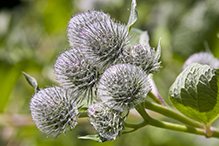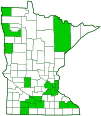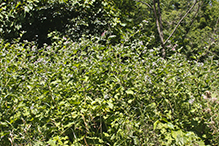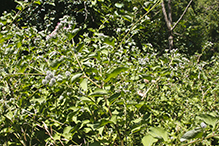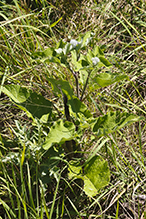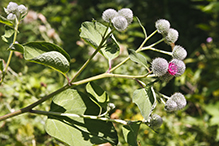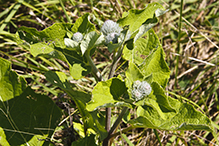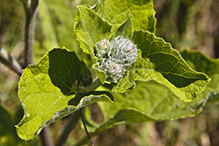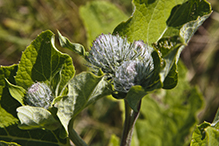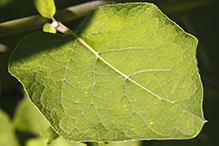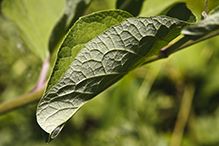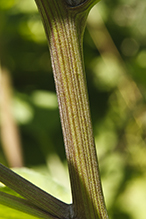woolly burdock
(Arctium tomentosum)
Conservation • Description • Habitat • Ecology • Use • Distribution • Taxonomy
Conservation Status |
|
|||||||
| IUCN Red List | not listed |
|||||||
| NatureServe | NNA - Not applicable |
|||||||
| Minnesota | not listed |
|||||||
Description |
||
Woolly burdock is a 2′ to 4′ tall, rarely taller, erect, biennial forb that rises on a single stem from a fleshy taproot. In its first year of growth this produces a rosette of basal leaves. In the second year it produces a hollow stalk that is branched, hairy, and ridged. Basal leaves are large, heart shaped and indented at the base where they attach to the leaf stalks. They are 12″ to 15″ long and 6″ to 11″ wide. The leaf stalk is 4″ to 6″ long, mostly hollow, and is covered with glandular hairs. The upper surface of the blade is green with sparse short hairs. The lower surface is light green or gray-green, with a thin covering of white, matted, short, soft, woolly hairs. The margins are wavy and are untoothed or may have small teeth. By the time the flowers are fully open the basal leaves are usually withered. Stem leaves are much smaller, alternate, and egg-shaped, getting progressively smaller toward the top of the stem. The inflorescence is a cluster of stalked flower heads with the outer ones on longer stalks, forming a flat-topped or convex cluster. The clusters appear at the end of the stem and in the upper leaf axils. Flower heads have about 30 rose purple, occasionally white, florets, are ½″ to 1″ wide, and are on ½″ to 4¾″ long stalks. The whorl of overlapping bracts subtending the flower head is 1″ to 1½″ in diameter and is densely woolly or cobwebby. The bracts are hooked at the tip. When dry the flower head becomes a bur resembling a thistle. Thistles, however, do not have hooked bracts. |
||
Height |
||
2′ to 4′, rarely taller |
||
Flower Color |
||
Rose purple, occasionally white |
||
Similar Species |
||
Common burdock (Arctium minus) leaves are usually more wavy. The flower heads are not densely cobwebby and are on short stalks or no stalks at all. Great burdock (Arctium lappa) has flower heads on long stalks. The inflorescence is a group of stalked flower heads with the outer ones on longer stalks, forming a flat-topped or convex cluster. |
||
Habitat |
||
Disturbed sites, roadsides. |
||
Ecology |
||
Flowering |
||
July to October |
||
Pests and Diseases |
||
|
||
Use |
||
|
||
Distribution |
||||
|
Sources |
|||
| 4/28/2023 | ||||
Nativity |
||||
Native to Asia and Europe. Introduced and naturalized in the United States. Potentially invasive. |
||||
Occurrence |
||||
Uncommon. Locally common in southwestern Minnesota. |
||||
Taxonomy |
|||
| Kingdom | Plantae (Plants) | ||
| Division | Tracheophyta (Vascular Plants) | ||
| Subdivision | Spermatophytina (Seed Plants) | ||
| Class | Magnoliopsida (Dicots) | ||
Order |
Asterales (Sunflowers, Bellflowers, Fanflowers, and Allies) | ||
Family |
Asteraceae (Sunflowers, Daisies, Asters, and Allies) | ||
| Subfamily | Carduoideae (thistles and allies) | ||
| Tribe | Cardueae | ||
| Subtribe | Carduinae (thistles and burdocks) | ||
| Genus | Arctium (burdocks) | ||
Cardueae is a synonym of the tribe name. Cynareae was published first and has precedence. Nevertheless, most sources use the name Cardueae for the tribe. |
|||
Subordinate Taxa |
|||
|
|||
Synonyms |
|||
Arctium leptophyllum Lappa tomentosa |
|||
Common Names |
|||
cotton burdock hairy burdock woolly burdock |
|||
Glossary
Axil
The upper angle where the leaf stalk meets the stem.
Glandular hairs
Hairs spread over aerial vegetation that secrete essential oils. The oils act to protect against herbivores and pathogens or, when on a flower part, attract pollinators. The hairs have a sticky or oily feel.

Slideshows |
||

Visitor Videos |
|||
Share your video of this plant. |
|||
| This button not working for you? Simply email us at info@MinnesotaSeasons.com. Attach a video, a YouTube link, or a cloud storage link. |
|||
Other Videos |
|||
| Schamloses Treiben von Harmonia axyridis auf Arctium tomentosum (1) URSchmidt |
|||
About
Published on Jul 1, 2012 Pärchen von Harmonia axyridis bei der Begattung |
|||

Visitor Sightings |
|||||
Report a sighting of this plant. |
|||||
| This button not working for you? Simply email us at info@MinnesotaSeasons.com. Be sure to include a location. |
|||||
|
|||||
MinnesotaSeasons.com Sightings |
|||||

|
Created: Last Updated: © MinnesotaSeasons.com. All rights reserved. |
